by Ray Linville
Nothing says spring like the arrival of flower blossoms, particularly in the Sandhills and eastern North Carolina with blooms on acres and acres of peach trees.
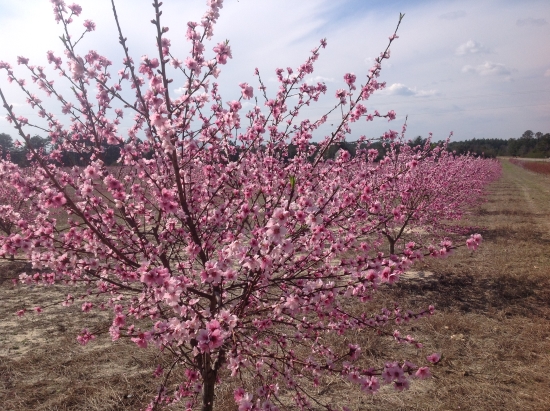
stand ready for their early spring pruning.
Many in North Carolina believe that our state’s peaches are the best (they’re right) and that peaches are native to the South (they’re wrong). Cultivated in China for more than 3,000 years, peaches arrived in the Americas in 1571 when Spanish missionaries introduced them along the Atlantic coast in an area known now as St. Simons Island, Georgia. More than 50 years later, George Minifie of England brought the first peach trees to the British colonies in North America and cultivated them at his estate near Jamestown, Virginia.
Peaches thrive in the rain, heat, and soil conditions of our state and other southern states. They are a vital fruit crop in the agricultural economy of several N.C. counties. However, as much as Mother Nature nurtures, a peach orchard is not self-sufficient. It requires constant monitoring and care, particularly pruning.
A few days after the trees on N.C. 211 (a favorite route for N.C. travelers heading to the coast) in the Eagle Springs community burst into color, I noticed a worker pruning in a peach orchard on a Sunday afternoon in late March. The sight compelled me to stop and ask him about his work.
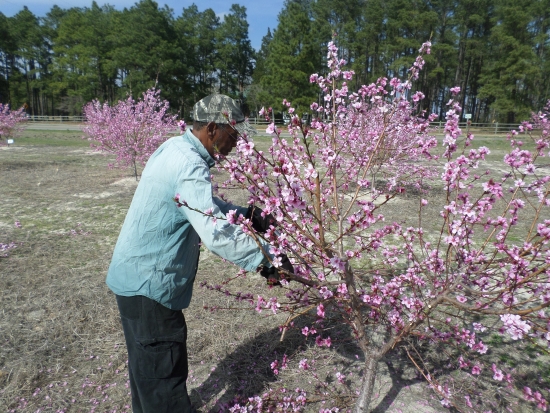
“I’m just trimming them back to reduce the weight on each tree. Trying to get through before it rains,” said Johnnie McBride, who was so concentrated on his work that he didn’t stop as I asked questions and he responded with short, pithy answers. His 68-year-old, lean, muscular frame honed from years in the field was more than ready for the task.
In contrast to apple and pear trees, peach trees are easy to train and prune. In their first three years, peach trees are trained to grow in a shape that allows them to bear a full crop. In addition to keeping trees at a desirable height, pruning keeps trees open to light and helps to maintain fruit production close to the trunk.
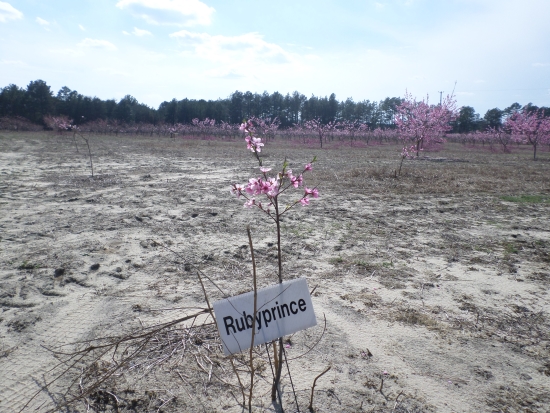
to a shape that allows them to bear a full crop.
Usually McBride also pulls a few blossoms off to thin out how many are on a branch. Because peach trees have a tendency to overbear and frequently split if the crop load is too heavy, thinning of blossoms is required to increase fruit size and crop load. How much space is needed between blossoms? “About this much,” he gestures and shows a distance between two fingers of about four inches. “I might need to leave more blooms on this year to see if they come out all right,” he said.
Before arriving in the orchard, he said he had spent the morning at Bethel Missionary Baptist Church on Windblow Road in Jackson Springs. How long would he stay in the orchard? “I’ll be here til dark,” he said.
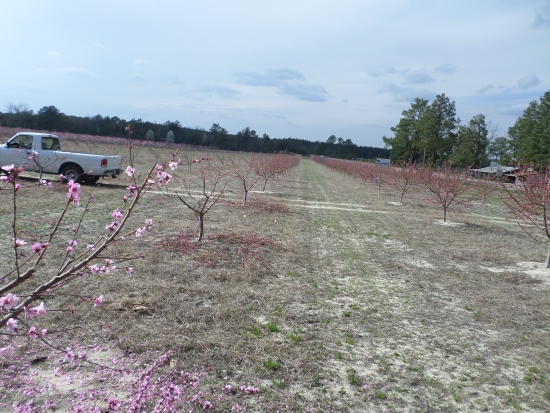
that any activity is happening in the orchard.
As McBride gently moved among the delicate peach blossoms, I could tell that he was thinking about their fragility. Uncovered open flowers are the least cold resistant of peach buds. When I asked him if the blossoms were still vulnerable to cold weather, he said, “We’ve got it made if we can make it through the Easter snap,” he said referring to damage that a drop in temperature can cause.
About 5,000 peach trees grow at Kalawi Farm, which is owned by Art and Jan Harman Williams where McBride has worked for decades. “I’ve worked for her [Jan] for 20 years. Before that, I worked for her dad – tobacco and cotton too,” he said with pride.
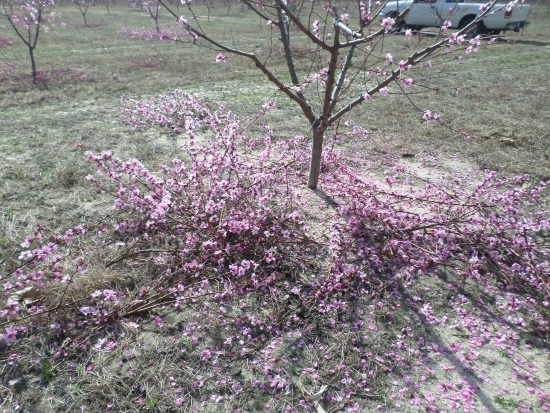
About Jan Williams’ father (Patt C. Harman, Jr.), McBride said, “I was raised up on his farm.” Harman took over Sand Pit Orchard in the 1940s that his namesake father had begun in the 1920s, and his career included being president of the N.C. Peach Growers Society. Williams, his son-in-law, has followed him as society president.
Development of the peach industry in the Sandhills began in earnest in 1892 when John Van Lindley planted 50,000 trees in Moore County near Southern Pines. Peaches then and in the early 1900s weren’t grown for local consumption as they are today. The rail lines built to move timber and naval stores such as turpentine from the longleaf pine forests were used to transport peaches to New York and other East Coast cities when refrigerated boxcars became available.
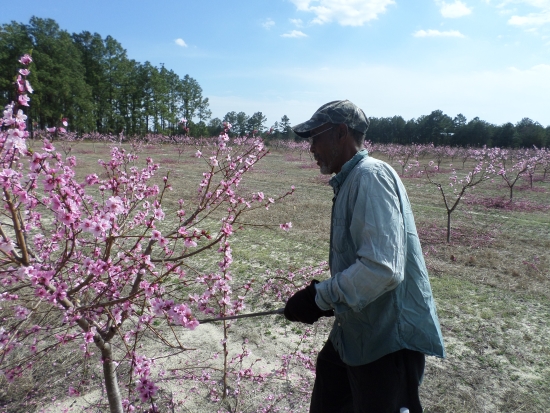
Today, according to the N.C. Cooperative Extension, most peaches produced in our state are sold at roadside retail outlets. In fact, many Triad and Triangle residents travel by peach orchards on their way to the beaches and other coastal destinations and stop for fresh peaches on their way home, if not in both directions. The roadside stand of Kalawi Farm is always busy after it opens around Easter. Before it closes by Thanksgiving, the 35 varieties of peaches harvested on the farm — and homemade peach ice cream — entice thousands of travelers to stop.
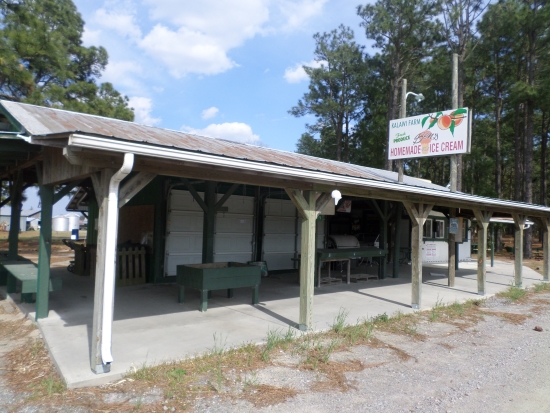
The pride by McBride in his work and his dedication to maintain a successful orchard were very apparent. “A peach orchard takes a lot of work,” he said. “Most people driving by don’t realize how much work it is.”

make a perfect spring centerpiece.
_______________________________________________________________
 Ray Linville writes and lectures on regional culture, including foodways and folklife. He has taught in the N.C. Community College System as a professor of English and humanities and served on the board of the N.C. Folklore Society. Read more about Ray’s ramblings at his blog: Sights, Sounds and Tastes of the American South.
Ray Linville writes and lectures on regional culture, including foodways and folklife. He has taught in the N.C. Community College System as a professor of English and humanities and served on the board of the N.C. Folklore Society. Read more about Ray’s ramblings at his blog: Sights, Sounds and Tastes of the American South.
RESOURCES
Growing Peaches in North Carolina
History of N.C. Peach Growers Society
Leave a Reply